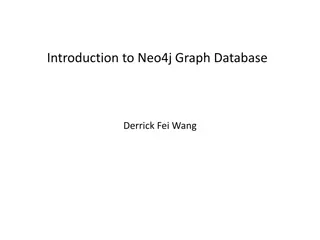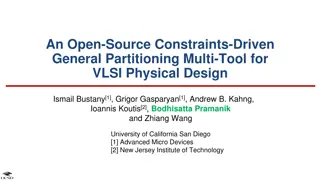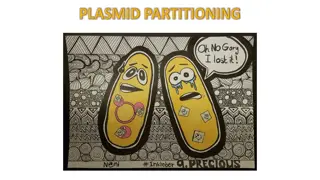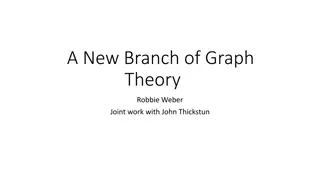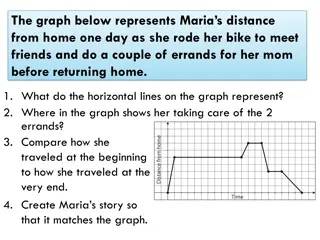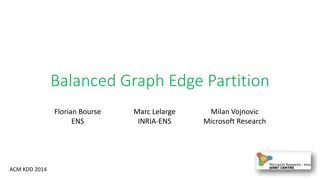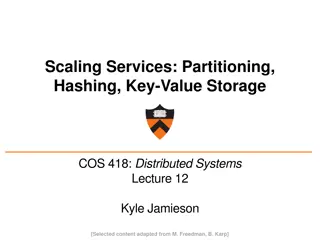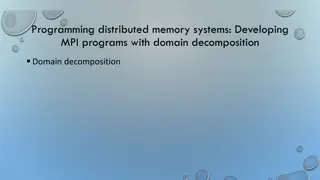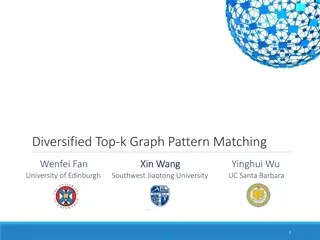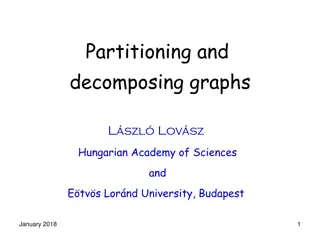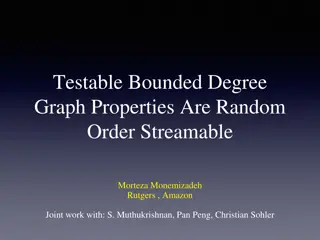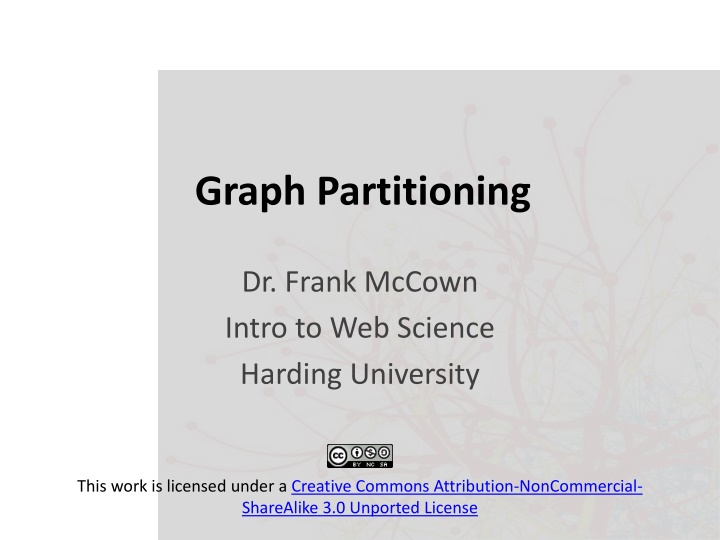
Methods for Graph Partitioning and Community Detection
Discover the world of graph partitioning and community detection with insights into algorithms like Girvan-Newman and techniques such as divisive and agglomerative methods. Explore how network structures can be broken down, identified, and analyzed for various applications in social and biological networks.
Download Presentation

Please find below an Image/Link to download the presentation.
The content on the website is provided AS IS for your information and personal use only. It may not be sold, licensed, or shared on other websites without obtaining consent from the author. If you encounter any issues during the download, it is possible that the publisher has removed the file from their server.
You are allowed to download the files provided on this website for personal or commercial use, subject to the condition that they are used lawfully. All files are the property of their respective owners.
The content on the website is provided AS IS for your information and personal use only. It may not be sold, licensed, or shared on other websites without obtaining consent from the author.
E N D
Presentation Transcript
Graph Partitioning Dr. Frank McCown Intro to Web Science Harding University This work is licensed under a Creative Commons Attribution-NonCommercial- ShareAlike 3.0 Unported License
Slides use figures from Ch 3.6 of Networks, Crowds and Markets by Easley & Kleinberg (2010) http://www.cs.cornell.edu/home/kleinber/networks-book/
Co-authorship network How can the tightly clustered groups be identified? Newmam & Girvan, 2004
Karate Club splits after a dispute. Can new clubs be identified based on network structure? Zachary, 1977
Graph Partitioning Methods to break a network into sets of connected components called regions Many general approaches Divisive methods: Repeatedly identify and remove edges connecting densely connected regions Agglomerative methods: Repeatedly identify and merge nodes that likely belong in the same region
Divisive Methods 1 10 2 3 9 11 7 8 4 6 12 13 5 14
Agglomerative Methods 1 10 2 3 9 11 7 8 4 6 12 13 5 14
Girvan-Newman Algorithm Proposed by Girvan and Newman in 2002: Community structure in social and biological networks Divisive method Identifies edges to remove using edge betweenness Edge betweenness: Total amount of flow an edge carries between all pairs of nodes where a single unit of flow between two nodes divides itself evenly among all shortest paths between the nodes (1/k units flow along each of k shortest paths)
Edge Betweenness Example 1 10 Calculate total flow over edge 7-8 2 3 9 11 7 8 4 6 12 13 5 14
1 10 One unit flows over 7-8 to get from 1 to 8 2 3 9 11 7 8 4 6 12 13 5 14
1 10 One unit flows over 7-8 to get from 1 to 9 2 3 9 11 7 8 4 6 12 13 5 14
1 1 10 10 One unit flows over 7-8 to get from 1 to 10 2 2 3 3 9 9 11 11 7 7 8 8 4 4 6 6 12 12 13 13 5 5 14 14
1 1 10 10 2 2 3 3 9 9 11 11 7 7 8 8 4 4 6 6 12 12 13 13 5 5 14 14 7 total units flow over 7-8 to get from 1 to nodes 8-14
1 10 2 3 9 11 7 8 4 6 12 13 5 14 7 total units flow over 7-8 to get from 2 to nodes 8-14
1 10 2 3 9 11 7 8 4 6 12 13 5 14 7 total units flow over 7-8 to get from 3 to nodes 8-14
7 x 7 = 49 total units flow over 7-8 from nodes 1-7 to 8-14 1 10 2 3 9 11 7 8 4 6 12 13 5 14
Edge betweenness = 49 1 10 2 3 9 11 7 8 4 6 12 13 5 14
1 10 Calculate betweenness for edge 3-7 2 3 9 11 7 8 4 6 12 13 5 14
1 10 3 units flow from 1-3 to each 4-14 node, so total = 3 x 11 = 33 2 3 9 11 7 8 4 6 12 13 5 14
Betweenness = 33 for each symmetric edge 1 10 2 3 9 11 33 33 7 8 33 33 4 6 12 13 5 14
1 10 Calculate betweenness for edge 1-3 2 3 9 11 7 8 4 6 12 13 5 14
1 10 Carries all flow to node 1 except from node 2, so betweenness = 12 2 3 9 11 7 8 4 6 12 13 5 14
1 1 10 10 betweenness = 12 for each symmetric edge 12 12 2 2 3 3 9 9 11 11 12 12 7 7 8 8 12 12 4 4 6 6 12 12 13 13 12 12 5 5 14 14
1 1 10 10 Calculate betweenness for edge 1-2 2 2 3 3 9 9 11 11 7 7 8 8 4 4 6 6 12 12 13 13 5 5 14 14
1 1 10 Only carries flow from 1 to 2, so betweenness = 1 2 2 3 3 9 11 7 8 4 6 12 13 5 14
1 1 10 10 betweenness = 1 for each symmetric edge 1 1 2 2 3 3 9 9 11 11 7 7 8 8 4 4 6 6 12 12 13 13 1 1 5 5 14 14
1 1 10 10 Edge with highest betweenness 1 12 1 12 2 2 3 3 9 9 11 11 12 12 33 33 49 7 7 8 8 33 33 12 12 4 4 6 6 12 12 13 13 1 12 12 1 5 5 14 14
Node Betweenness Betweenness also defined for nodes Node betweenness: Total amount of flow a node carries when a unit of flow between each pair of nodes is divided up evenly over shortest paths Nodes and edges of high betweenness perform critical roles in the network structure
Girvan-Newman Algorithm 1. Calculate betweenness of all edges 2. Remove the edge(s) with highest betweenness 3. Repeat steps 1 and 2 until graph is partitioned into as many regions as desired
Girvan-Newman Algorithm 1. Calculate betweenness of all edges 2. Remove the edge(s) with highest betweenness 3. Repeat steps 1 and 2 until graph is partitioned into as many regions as desired How much computation does this require? Newman (2001) and Brandes (2001) independently developed similar algorithms that reduce the complexity from O(mn2) to O(mn) where m = # of edges, n = # of nodes
Computing Edge Betweenness Efficiently For each node N in the graph 1. Perform breadth-first search of graph starting at node N 2. Determine the number of shortest paths from N to every other node 3. Based on these numbers, determine the amount of flow from N to all other nodes that use each edge Divide sum of flow of all edges by 2 Method developed by Brandes (2001) and Newman (2001)
Example Graph F B C I A D G K E H J
Computing Edge Betweenness Efficiently For each node N in the graph 1. Perform breadth-first search of graph starting at node N 2. Determine the number of shortest paths from N to every other node 3. Based on these numbers, determine the amount of flow from N to all other nodes that use each edge Divide sum of flow of all edges by 2
Breadth-first search from node A A B C E D F G H J I K
Computing Edge Betweenness Efficiently For each node N in the graph 1. Perform breadth-first search of graph starting at node N 2. Determine the number of shortest paths from N to every other node 3. Based on these numbers, determine the amount of flow from N to all other nodes that use each edge Divide sum of flow of all edges by 2
A B C 1 E 1 D 1 1 add add 2 1 F G H 2 add add J I 3 3 add K 6
Computing Edge Betweenness Efficiently For each node N in the graph 1. Perform breadth-first search of graph starting at node N 2. Determine the number of shortest paths from N to every other node 3. Based on these numbers, determine the amount of flow from N to all other nodes that use each edge Divide sum of flow of all edges by 2
A B C 1 E 1 D 1 1 2 1 F G H 2 J I 3 3 Work from bottom-up starting with K K 6
A B C 1 E 1 D 1 1 2 1 F G H 2 J I 3 3 K gets 1 unit; equal, so evenly divide 1 unit K 6
A B C 1 E 1 D 1 1 2 1 F G H 2 1 I keeps 1 unit & passes along unit; gets 2 times as much from F J I 3 3 K 6
A B C 1 E 1 D 1 1 2 1 F G H 2 1 1 J keeps 1 unit & passes along unit; gets 2 times as much from H J I 3 3 K 6
A B C 1 E 1 D 1 1 1 1 2 1 F G H 2 1 1 F keeps 1 unit & passes along 1 unit; equal, so divide evenly J I 3 3 K 6
A B C 1 E 1 D 1 1 1 1 2 2 1 F G H 2 1 1 G keeps 1 unit & passes along 1 unit J I 3 3 K 6
A B C 1 E 1 D 1 1 1 1 2 1 1 2 1 F G H 2 1 1 H keeps 1 unit & passes along 1 unit; equal, so divide evenly J I 3 3 K 6
B keeps 1 & passes 1 A 2 B C 1 E 1 D 1 1 1 1 2 1 1 2 1 F G H 2 1 1 J I 3 3 K 6
C keeps 1 & passes 1 A 2 2 B C 1 E 1 D 1 1 1 1 2 1 1 2 1 F G H 2 1 1 J I 3 3 K 6
D keeps 1 & passes along 3 A 2 4 2 B C 1 E 1 D 1 1 1 1 2 1 1 2 1 F G H 2 1 1 J I 3 3 K 6
E keeps 1 & passes along 1 A 2 2 4 2 B C 1 E 1 D 1 1 1 1 2 1 1 2 1 F G H 2 1 1 J I 3 3 K 6
No flow yet A 2 2 4 2 B C 1 E 1 D 1 1 1 1 2 1 1 2 1 F G H 2 1 1 J I 3 3 K 6
Computing Edge Betweenness Efficiently For each node N in the graph 1. Perform breadth-first search of graph starting at node N 2. Determine the number of shortest paths from N to every other node 3. Based on these numbers, determine the amount of flow from N to all other nodes that use each edge Divide sum of flow of all edges by 2 Repeat for B, C, etc. Since sum includes flow from A B and B A, etc.




